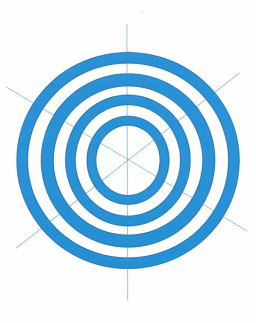|
As an athlete, you have probably heard a lot about the importance of setting goals for motivation and continued success. There are guidelines for setting goals (see Staying Motivated: The Principles of Goal Setting) which are pretty straightforward. What can be difficult, though, is deciding what skill areas or behaviors should be the targets of goals you set. Do you need to set a goal to learn to hold the bat if you have no difficulty doing so? A simple tool to help you define what areas you may need to improve is a target board. Draw a target on a piece of paper, with at least 5-7 concentric circles. Next, consider behaviors, skills and attributes necessary for success in your sport. These should be general and objective, not specific to you (yet). What do you think an elite athlete in your sport would have, as far as skills, behaviors and physical attributes? For example, consider a soccer player, and what he or she might list:
Now look at your own list and circle the items you feel you could improve upon in your game. If you circle six items, divide your target into six sections like pie pieces. Seven items, seven sections, and so on. Label each section. Next, using the bullseye as the "elite" level, rate yourself on each item, counting back ring by ring until you get to where you feel you currently fall on that scale. With the bullseye as perfect, the further from the bullseye you are, the more you need to work on this area. Put a mark there. When you have done this for each item, color in the sections from your mark to the bullseye. When you have finished, you will have a visual representation of skills and behaviors you feel you need to work on, and where you may need to apply more or less effort to setting goals. This visual method is very effective for creating your mindset to attain goals you seek. You may also find that you have actually been focusing on areas in the past where you really are already better skilled. You can now use more effective time management, be more focused with your efforts in training. Your training will be more effective and productive overall.
Be sure to take the next step, actually setting goals in each area so you can achieve the "bullseye" all around. Follow up after a certain time (6 weeks, 3 months, whatever you set as your timetable), and re-do the target with your new assessment rankings. Make sure you are progressing each time. It might be helpful to have a teammate or coach help with the whole assessment process as well, either from the beginning, or once you do your reassessment, for a second opinion and support as you work toward your goals. If you are not making progress, you may need to look at the specific goals you created for each area, and make sure that the steps you envisioned needing to take to reach the goal really will take you where you want to go. Remember, the target areas are general, based on your idea of an elite player. Your goals, once you set them, will be much more specific. By meeting your specific goals, you will form a better mental picture, mental rating of yourself in relation to that elite player. Eventually, you will find yourself right "on target."
0 Comments
|
Articles for Athletes
Information to help you achieve your personal best performance! Archives
February 2016
Categories
All
|




